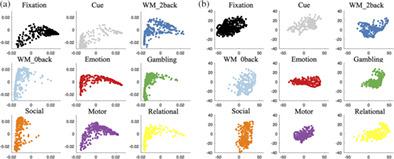当前位置:
X-MOL 学术
›
Hum. Brain Mapp.
›
论文详情
Our official English website, www.x-mol.net, welcomes your feedback! (Note: you will need to create a separate account there.)
Nonlinear manifold learning in functional magnetic resonance imaging uncovers a low-dimensional space of brain dynamics
Human Brain Mapping ( IF 4.8 ) Pub Date : 2021-06-29 , DOI: 10.1002/hbm.25561 Siyuan Gao 1 , Gal Mishne 2, 3 , Dustin Scheinost 1, 4, 5, 6
Human Brain Mapping ( IF 4.8 ) Pub Date : 2021-06-29 , DOI: 10.1002/hbm.25561 Siyuan Gao 1 , Gal Mishne 2, 3 , Dustin Scheinost 1, 4, 5, 6
Affiliation

|
Large-scale brain dynamics are believed to lie in a latent, low-dimensional space. Typically, the embeddings of brain scans are derived independently from different cognitive tasks or resting-state data, ignoring a potentially large—and shared—portion of this space. Here, we establish that a shared, robust, and interpretable low-dimensional space of brain dynamics can be recovered from a rich repertoire of task-based functional magnetic resonance imaging (fMRI) data. This occurs when relying on nonlinear approaches as opposed to traditional linear methods. The embedding maintains proper temporal progression of the tasks, revealing brain states and the dynamics of network integration. We demonstrate that resting-state data embeds fully onto the same task embedding, indicating similar brain states are present in both task and resting-state data. Our findings suggest analysis of fMRI data from multiple cognitive tasks in a low-dimensional space is possible and desirable.
中文翻译:

功能磁共振成像中的非线性流形学习揭示了大脑动力学的低维空间
大规模的大脑动力学被认为存在于一个潜在的低维空间中。通常,脑部扫描的嵌入独立于不同的认知任务或静息状态数据,忽略了该空间中可能较大且共享的部分。在这里,我们确定可以从基于任务的功能磁共振成像 (fMRI) 数据的丰富库中恢复共享、稳健和可解释的大脑动力学低维空间。当依赖非线性方法而不是传统的线性方法时,就会发生这种情况。嵌入保持任务的适当时间进展,揭示大脑状态和网络集成的动态。我们证明静息状态数据完全嵌入到相同的任务嵌入中,表明任务和静息状态数据中都存在相似的大脑状态。
更新日期:2021-09-02
中文翻译:

功能磁共振成像中的非线性流形学习揭示了大脑动力学的低维空间
大规模的大脑动力学被认为存在于一个潜在的低维空间中。通常,脑部扫描的嵌入独立于不同的认知任务或静息状态数据,忽略了该空间中可能较大且共享的部分。在这里,我们确定可以从基于任务的功能磁共振成像 (fMRI) 数据的丰富库中恢复共享、稳健和可解释的大脑动力学低维空间。当依赖非线性方法而不是传统的线性方法时,就会发生这种情况。嵌入保持任务的适当时间进展,揭示大脑状态和网络集成的动态。我们证明静息状态数据完全嵌入到相同的任务嵌入中,表明任务和静息状态数据中都存在相似的大脑状态。



























 京公网安备 11010802027423号
京公网安备 11010802027423号